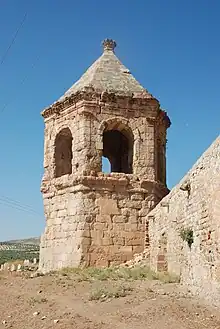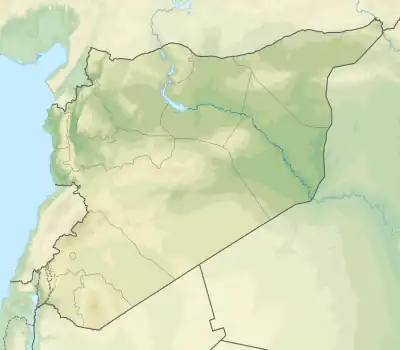| Mosque of the Prophet Huri | |
|---|---|
 The pyramidal-roofed tower tomb of Nebi Huri, which is part of the mosque complex. | |
| Religion | |
| Affiliation | Islam |
| Province | Aleppo Governorate |
| Status | Active |
| Location | |
| Location | Cyrrhus, Aleppo Governorate, Syria |
 Location in Aleppo Governorate  Mosque of Prophet Huri (Turkey) | |
| Geographic coordinates | 36°44′07″N 36°57′13″E / 36.7353866°N 36.9535671°E |
| Architecture | |
| Type | mausoleum, later mosque |
| Style | Roman, Mamluk, Ottoman |
| General contractor |
|
| Date established |
|
| Specifications | |
| Shrine(s) | 1 |
| Materials | stone |
The Mosque of the Prophet Huri or Nebi Huri Mosque (in Arabic: مسجد النبي هوري, in Turkish: Peygamber Huri Camii) is a mosque and mausoleum located at the archeological site of Cyrrhus near Afrin, Syria. It was formerly known as the Nebi Huri Mausoleum (ضريح النبي هوري/Peygamber Huri Turbesi) as well.
It is built around a Roman-period hexagonal tower tomb which was converted into a Muslim shrine or mausoleum during the Mamluk period.
Nebi Huri

Nebi Huri was a Sufi saint, whom the locals believed had the abilities to grant the wishes of anyone who was sincere.[1] Other traditions cite the name of Nebi Huri as being "Prophet Huri" as an Islamicized version of Uriah the Hittite who was a military general for the army of King David.[2] However, the tomb is actually that of a military commander who worked under the Roman Empire.[3]
History
Roman era
%252C_Syria_-_South_facade_-_PHBZ024_2016_2215_-_Dumbarton_Oaks.jpg.webp)
The building was originally a hexagonal tower tomb, dated to have been built during the 2nd or 3rd century BC, during the rule of the Roman Empire.[3][4] It is also described as being a tomb for a Roman military commander. The site surrounding the tomb, and possibly the tomb itself, was damaged in 1140, during Crusader rule, by a huge earthquake.[3][4]
Mamluk era
During the rule of the Mamluk Sultanate, in 1303, the tower tomb was given a new attribution to a saint named Nebi Huri.[3][4] The Roman cemetery next to the tomb became used for Muslim burials.[3][4] In the same year, the tower tomb was converted into a Muslim shrine, and its bottom level became known as the grave of Nebi Huri.[5] In the year 1314, a mosque was built next to the tower tomb by Ala ad-Din ibn Altunbugha, the Mamluk governor of Aleppo.[3][4]
Ottoman era
During Ottoman rule, in the year 1875, the old Mamluk-era mosque was demolished and a new mosque building replaced it.[3][4] The mosque was used as a congregational mosque, where the Friday prayers were performed.[4][3] It was a prominent site of visit by the residents of nearby villages.[3][4]
Modern history
The tower tomb was damaged and looted during the Afrin offensive in 2018.[5] It was reported that soldiers of the Free Syrian Army ransacked the tomb looking for treasure.[5] They had also overturned the wooden cenotaph over the tomb of Nebi Huri, and threw rubbish all over the tomb's floor.[5] Precious items were allegedly stolen from the places around the tomb as well.[1]
%252C_Syria_-_Detail_view_-_PHBZ024_2016_2217_-_Dumbarton_Oaks.jpg.webp)
In 2020, after the wars in that region had ended, Turkish authorities reconstructed the Nebi Huri mausoleum.[1][6] It was also incorporated into part of a larger mosque complex, known as "Mosque of the Prophet Huri" but several old artifacts which remained at the site were destroyed and removed.[1][6] The Turkish renovations added a wooden balcony to the mosque, but the minbar of the mosque was replaced with a new wooden one which was more evocative of Ottoman architecture.[6] The restoration efforts by the Turkish government were criticized as an attempt to "Ottoman-nize" Syrian history and heritage, because of the fact that historical heritage was removed and destroyed during the renovation.[1][6]
See also
References
- 1 2 3 4 5 "Mausoleum of Nebi Huri in occupied Afrin converted into mosque". ANF News. Retrieved 2023-12-19.
- ↑ "Syria's Afrin, a perennial battleground". dianadarke. 2018-02-28. Retrieved 2023-12-19.
- 1 2 3 4 5 6 7 8 9 محرر 13 (2018-02-19). "مدينة "النبي هوري" أبرز المناطق التاريخية في عفرين.. تعرف عليها". عنب بلدي (in Arabic). Retrieved 2023-12-19.
{{cite web}}: CS1 maint: numeric names: authors list (link) - 1 2 3 4 5 6 7 8 "منطقة النبي هوري.. كنز أثري مهدد بالاندثار". المسرى (in Arabic). 2021-11-06. Retrieved 2023-12-19.
- 1 2 3 4 "CHI – Incident Report Feature – Intentional Destruction of Religious Sites in Afrin - American Society of Overseas Research (ASOR)". 2019-09-12. Retrieved 2023-12-19.
- 1 2 3 4 publish2 (2021-08-30). "Turkey Ottomanizes old heritage sites in Syria's Afrin". North press agency. Retrieved 2023-12-19.
{{cite web}}: CS1 maint: numeric names: authors list (link)